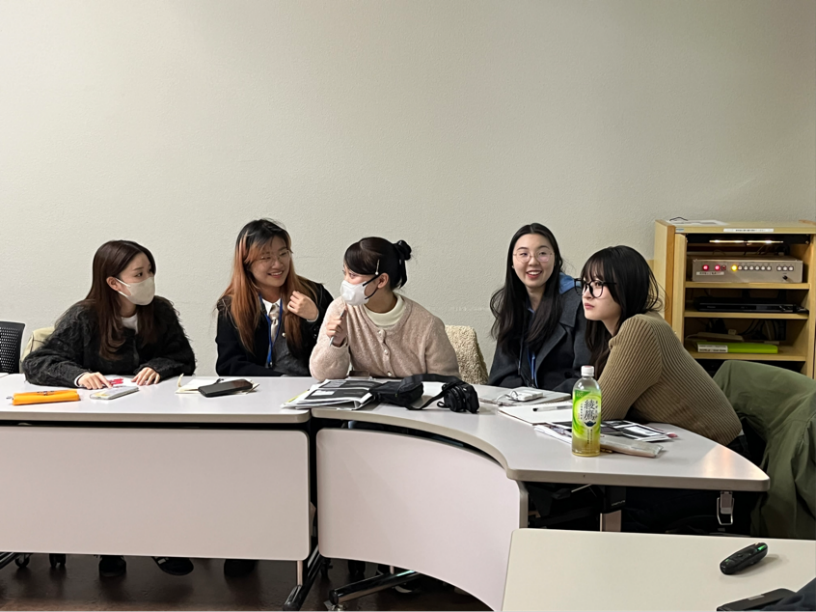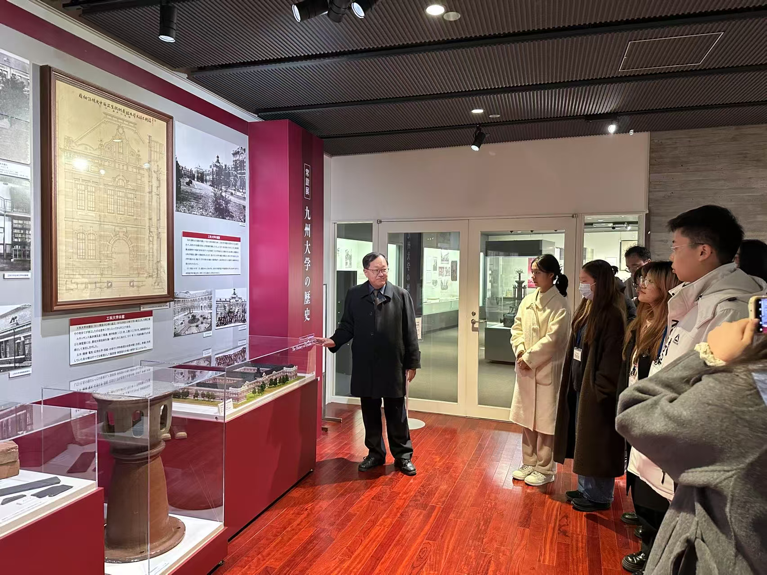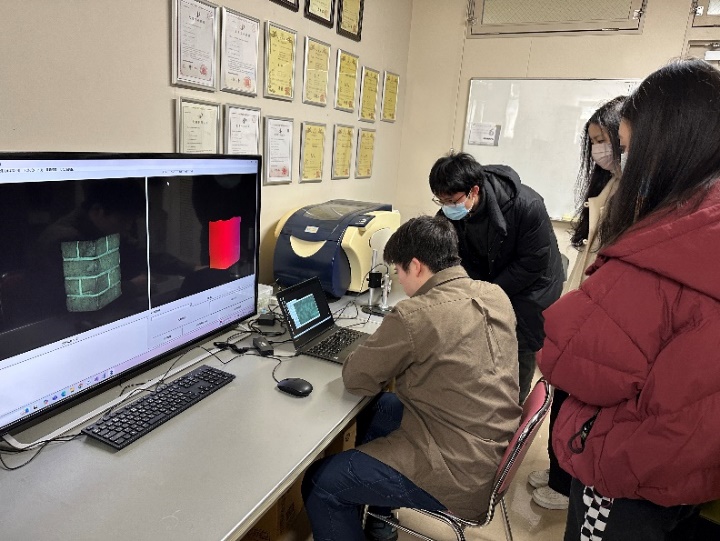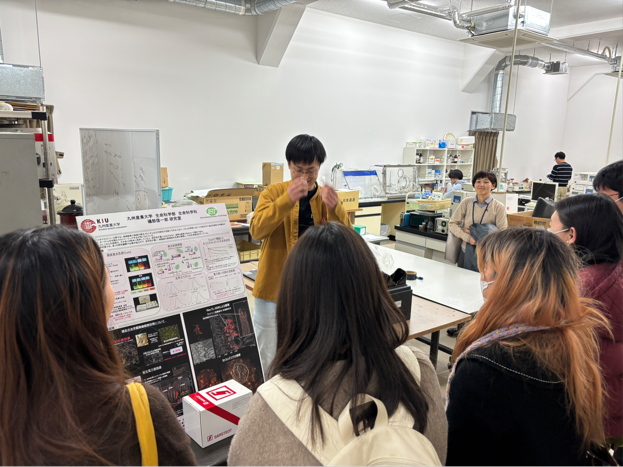SJTU Faculty and Students Participate in Sakura Science Program in Japan
From January 19th to 25th, 2025, under the financial support of the “Sakura Science Program” of the Japan Science and Technology Agency (JST), a group of eight students from Shanghai Jiao Tong University (SJTU) , led by Ms. Jin Wenfeng, the head of Japanese Department of the School of Foreign Languages, carried out a seven-day exchange visit to Fukuoka, Japan. The Japanese sponsor of the program was the Fukuoka Urban Research Center (URC) in Fukuoka, Japan. Through academic lectures, field study, dialogues and exchanges, the students carried out an in-depth study interwoven with science and technology and humanities.
Academic Dialogue: Touching the Pulse of Innovation
The delegation of Shanghai Jiao Tong University has visited four characteristic universities to stimulate innovative thinking in the collision of disciplines. Prof. Wang Zhongyi of Seinan Gakuin University opened the first thought-stirring session with a lecture on the theme of aesthetics and business. The Chinese and Japanese students divided into small groups to discuss the similarities and differences between Chinese and Japanese art works and aesthetics concepts to search for cultural resonance in the value system. Prof. Mang Sakai of the Department of Architecture of Kyushu University shared the design concepts of the nine major campuses of Kyushu University through the theme of “University and Region”, and led the teachers and students to visit the characteristic buildings, library, exhibition hall and 3,000-people auditorium, etc., in which the history of the school and the energy-saving and flexible design concepts were vividly displayed in front of their eyes. Prof. Lu personally explained to the teachers and students of Shanghai Jiao Tong University the 3D imaging system for real-time monitoring of the sea 20 kilometers away, which vividly interpreted the realistic value of disaster prevention research. Prof. Yukiko Nakahara of Kyushu Sangyo University, on the other hand, used the introductory lectures on “microbubble technology” and fluorescent particles and a series of magical lab displays to show the marvelous transformation of basic research into medical, criminal investigation and other applications in daily life.

Group discussion between Shanghai Jiao Tong University students and Seinan Gakuin University students

Visit to Kyushu University led by Prof. Mang Sakai

Visit 3D measurement technology, the core patent of Prof. Lu Cunwei's team at Fukuoka Institute of Technology

Laboratory visit by Prof. Yukiko Nakahara's team at Kyushu Sangyo University
In the academic exploration of science and technology and humanities, the delegation appreciated the charm of innovation, and were also touched by the researchers' spirit of perseverence, which help stimulate them to achieve unremitting progress in the future.
Cultural Charm: Perceiving the Beauty of Inheritance
When science and technology exploration met cultural inheritance, the visiting group came to understand the time philosophy of “past-present-future” at the Miebashi Bridge of Dazaifu Tenmangu Shrine, and reacquainted themselves with the history of East Asian civilization exchanges in the Silk Road artifacts of the Kyushu National Museum. On Setsubun Day, the Hakata Ward Office's bean-scattering and evil-dispelling ceremony revitalizes traditional folklore, while the aroma of umeboshi (plum branch cake) in front of the statue of the divine cow transformed the cultural experience into a memory on the tip of the tongue. These dialogues across time and space allowed the students to realize that technological innovation needed to take root in cultural soil to blossom brilliantly .
%20(1).png)
Taizaifu Tenmangu Shrine and Kyushu National Museum
Urban Microcosm: Deconstructing the Code of Livability
URC researcher Shono Hatakeyama's sand table revealed the code of Fukuoka's development: As a coastal city with less than one-third of Tokyo's population, Fukuoka led the world in commuting efficiency with its “15-minute living circle” plan, and created a model for livability with a compact layout. From the design of Gion Station to the use of vertical space on the rooftop of Hakata Station's Railway Shrine, the concept of a humanized city was reflected in the city's design. As stated in the lecture on Fukuoka's urban policy, not a mega city, but a warm city of sustainable development.
Two-way Journey: Building a Bridge of Friendship
During the walk along the coastline of Seinan Gakuin University, Chinese and Japanese students discussed the current situation and thought about the future; in the laboratory of Kyushu Sangyo University, teachers and students of the two universities discussed and exchanged views on various equipments and research contents; students of the delegation took the initiative to ask questions, which were patiently answered by the professors and graduate students in the laboratory; at the closing ceremony, the group presented their report in Chinese, Japanese and English, which won the praise of the URC staff and experts, and the students expressed their sincere thanks to the staff and teachers who had taken care of them these days. As the airplane swept over Hakata Bay in the morning sun, the young hearts carrying the seeds of cross-cultural understanding was about to take root in a wider world.
.png)
Group photo of the delegation with two students from Seinan Gakuin University.
.png)
Results Report
.png)
Ms. Jin presented a souvenir of Shanghai Jiao Tong University to Mr. Miyagawa, the director of URC
During the visit, the students not only improved their Japanese and English communication skills and international vision, but also gained a new understanding of Japanese culture, science and technology, humanities and social sciences. They expressed that they would study harder in the future and strive to become more excellent compound talents in the new era. This program was not only about knowledge acquisition, but also about a way of thinking innovation. Students were expected to transform what they saw and learned in Fukuoka into energy for social progress. Just as the motto of Fukuoka Tower night lights when they first came on - this is not the end, but the beginning of a new voyage.
